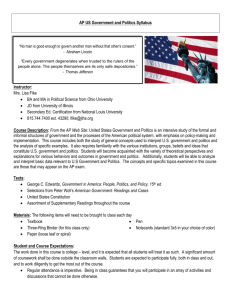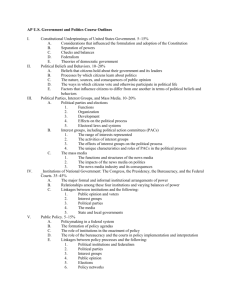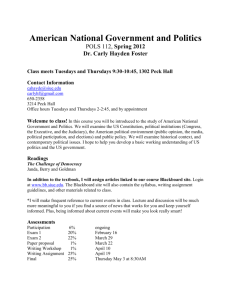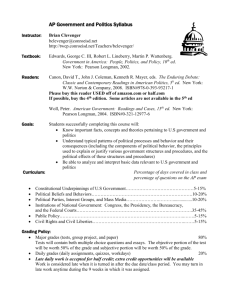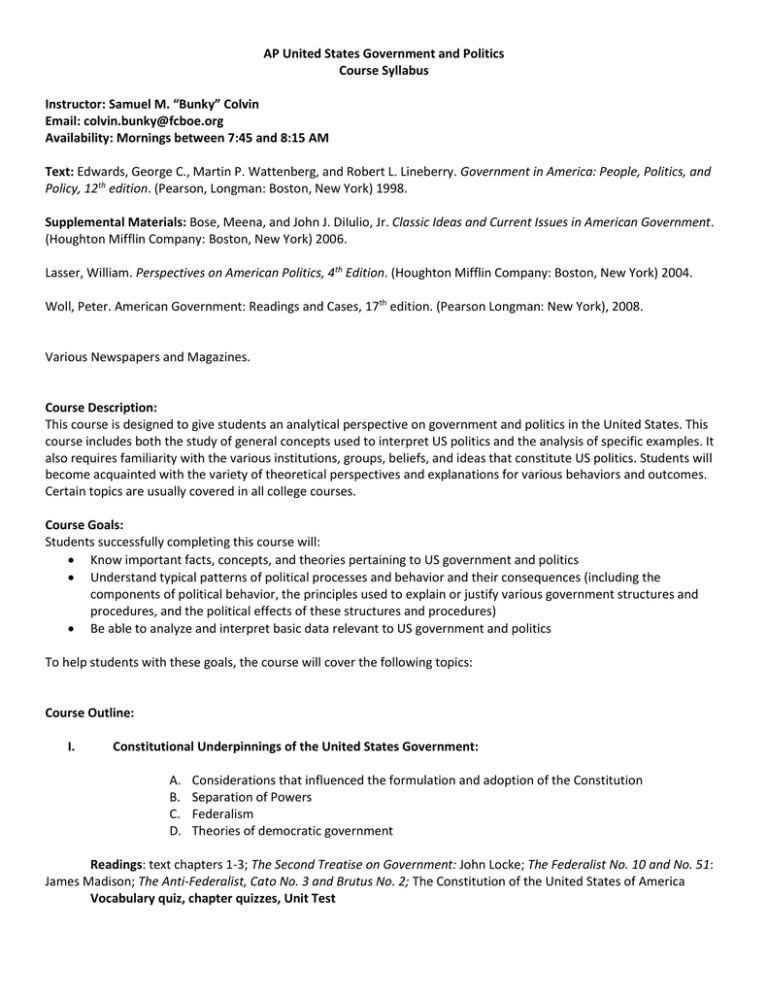
AP United States Government and Politics
Course Syllabus
Instructor: Samuel M. “Bunky” Colvin
Email: colvin.bunky@fcboe.org
Availability: Mornings between 7:45 and 8:15 AM
Text: Edwards, George C., Martin P. Wattenberg, and Robert L. Lineberry. Government in America: People, Politics, and
Policy, 12th edition. (Pearson, Longman: Boston, New York) 1998.
Supplemental Materials: Bose, Meena, and John J. DiIulio, Jr. Classic Ideas and Current Issues in American Government.
(Houghton Mifflin Company: Boston, New York) 2006.
Lasser, William. Perspectives on American Politics, 4th Edition. (Houghton Mifflin Company: Boston, New York) 2004.
Woll, Peter. American Government: Readings and Cases, 17th edition. (Pearson Longman: New York), 2008.
Various Newspapers and Magazines.
Course Description:
This course is designed to give students an analytical perspective on government and politics in the United States. This
course includes both the study of general concepts used to interpret US politics and the analysis of specific examples. It
also requires familiarity with the various institutions, groups, beliefs, and ideas that constitute US politics. Students will
become acquainted with the variety of theoretical perspectives and explanations for various behaviors and outcomes.
Certain topics are usually covered in all college courses.
Course Goals:
Students successfully completing this course will:
Know important facts, concepts, and theories pertaining to US government and politics
Understand typical patterns of political processes and behavior and their consequences (including the
components of political behavior, the principles used to explain or justify various government structures and
procedures, and the political effects of these structures and procedures)
Be able to analyze and interpret basic data relevant to US government and politics
To help students with these goals, the course will cover the following topics:
Course Outline:
I.
Constitutional Underpinnings of the United States Government:
A.
B.
C.
D.
Considerations that influenced the formulation and adoption of the Constitution
Separation of Powers
Federalism
Theories of democratic government
Readings: text chapters 1-3; The Second Treatise on Government: John Locke; The Federalist No. 10 and No. 51:
James Madison; The Anti-Federalist, Cato No. 3 and Brutus No. 2; The Constitution of the United States of America
Vocabulary quiz, chapter quizzes, Unit Test
II.
Political Beliefs and Behaviors:
Student Objectives:
What is public opinion? Does government policy tend to coincide with public opinion?
What are the dimensions and characteristics of public opinion?
What is political socialization? What are the major agents of socialization?
What causes political opinion to change over time?
How does socioeconomic status influence political beliefs?
What is political ideology? Are Americans ideological?
What impact does religiosity have on political beliefs? Race? Gender? Age? Region?
Subunits:
A. Beliefs that citizens hold about their government and its leaders
B. Processes by which citizens learn about politics
C. The nature, sources, and consequences of public opinion
D. The ways in which citizens vote and otherwise participate in political life
E. Factors that influence citizens to differ from one another in terms of political beliefs and
behaviors
Readings: text chapters 6; “One Nation, Slightly Divisible”: David Brooks; “Engaging Youth: Combating the
Apathy of Young Americans Toward Politics”: Kevin Mattson; various analyses of demographic data
Vocabulary quizzes, chapter quizzes, Unit Test
III.
Political Parties, Interest Groups, and Mass Media
Student objectives:
What are political parties? How are they organized?
What do political parties do?
How did political parties develop? How are they characterized today?
What are linkage institutions? How are parties such institutions?
What is a two party system? Why do third parties have such a difficult time gaining traction in the
political landscape of the US?
What are interest groups? What tactics do they use to attract attention? Who do they seek to
influence?
What types of people join interest groups?
What is the difference between interest groups and political parties?
How are nominations for election made?
How does money influence election outcomes?
What steps are involved in nominating and electing politicians to office?
Who votes? Why?
How do the media influence public perception of politics?
How do the media influence the behavior of politicians?
Subunits:
A. Political Parties and elections
1. functions
2. organization
3. development
4. effects on the political process
B. Interest groups, including political action committees(PACs)
1. The range of interests represented
2. the activities of interest groups
3. the effects of interest groups on the political process
4. the unique characteristics and roles of PACs in the political process
C. The Mass Media
1. the functions and structures of the media
2. the impacts of media on politics
Readings: text chapters 7-11 . “Dynamics of the Party System: Alignment and Realignment of Political Parties in
the United States”: James L. Sundquist; “Even with Campaign Finance Law, Money Talks Louder Than Ever”:
Glen Justice; “Reforming the Electoral System”: Stephen J. Wayne; “Spin Cycle: How the White House and the
Media Manipulate the News”: Howard Kurtz
IV.
Institutions of National Government: The Congress, the Presidency, the Bureaucracy, and the Federal
Courts
Student Objectives:
What is the bureaucracy? How did it become such an essential part of the federal government?
How do the Congress and the President exercise control over the ‘fourth branch’ of government?
How is the bureaucracy organized?
What is a dual judicial system?
What is judicial review?
How do politics enter into the appointment of federal judges?
How does the judiciary influence policy making?
What factors must the President consider when appointing Supreme Court justices?
How are judicial appointments affected by the system of checks and balances?
Subunits:
A. The major formal and informal institutional arrangements of power
B. Relationships among these four institutions and varying balances of power
C. Linkages between institutions and the following:
1. public opinion and voters
2. interest groups
3. political parties
4. the media
5. sub national governments
Readings: text chapters 12-16. “What the American Public Wants Congress to Be”: John R. Hibbing and James T.
Smith; “Presidential Power and the Modern Presidents”: Richard E. Neustadt; “Bureaucracy: What Government
Agencies Do and Why They Do It”: James Q. Wilson; Marbury v. Madison
Vocabulary quizzes, chapter quizzes, Unit Test
V.
Public Policy
A.
B.
C.
D.
E.
Policymaking in a federal system
The formation of policy agendas
The role of institutions in the enactment of policy
The role of the bureaucracy and the courts in policymaking and interpretation
Linkages between policy processes and the following:
1. political institutions and federalism
2. political parties
3. interest groups
4. public opinion
5. elections
6. policy networks
7.
Readings: text chapters 17-20; “Nine Misconceptions about Social Security”: Dean Baker; “America and the
World”: Michael Hirsh
Vocabulary quizzes, chapter quizzes, Unit Test
VI.
Civil Rights and Civil Liberties:
A. The development of civil liberties and civil rights by judicial interpretation
B. Knowledge of substantive rights and liberties
C. The impact of the Fourteenth Amendment on the constitutional development of rights and
liberties
Readings: text chapters 4-5; “I Have a Dream”: Martin Luther King, Jr.; “Judicial Activism in Canada and the
United States”: Mark C. Miller; “Affirmative Action – Don’t Mend or End it – Bend It”: Peter H. Schuck;
“Multicultural Citizenship”: Will Kymlicka; various court cases
Vocabulary quizzes, chapter quizzes, Unit Test
Expectations: This is a college level course and will be taught as such. You are expected to come to class on time and
prepared. Failure to follow this policy will affect your grade. Follow all class rules and guidelines and take note of the
policy for failing to do this. Do not expect to be able to leave class to use the restroom. There are seven minutes
between classes and this should be ample time for you to handle your business. Turn your cell phone off as there will be
consequences if it rings!!! You are also expected to turn in homework and other assignments on time. Late assignments
will not be accepted without an EXCUSED absence. If you miss a test or a quiz, it is your responsibility to make it up. You
will not be reminded of missing work. See me or a classmate for missing notes, as there will be notes to take many days.
You have three days to complete a missing assignment – after that you will receive a grade of 0. You will have a
vocabulary quiz every Friday and those words will be posted on the mini board every week. Absence any day before the
quiz does not excuse you from having to take it on Friday. You will be told when tests are given well in advance. Absence
any day before the test does not excuse you from taking it on the day given. Please note this policy as there will be NO
exceptions.
Grading Policy:
Essays/Free Response 30%
Homework: 5%
Tests (including projects): 45%
Final: 20%
Grading Rubric:
In order to receive the grade of A: Work is exemplary and above level. Student exhibits
a mastery of the subject, participates in class and is
prepared and on time.
In order to receive the grade of B: Work is superior and on level. Student exhibits a
mastery of the subject, participates in class and is
prepared and on time.
In order to receive the grade of C: Work is unexceptional, but on level, and lacks effort.
Student exhibits a working knowledge of the subject,
but often fails to participate in class and is often
unprepared.
In order to receive the grade of D: Student is ill prepared and work lacks minimal effort.
In order to receive the grade of F: Work is poor and does not meet any class requirements.
Final Note:
This is a college level course. In order to be successful in it you must work hard to meet expectations. Do your homework as it
will review concepts taught in class. Ask questions if you do not understand. Please do not hesitate to contact me if you do not
understand something. Failure to grasp certain concepts means that you will not grasp others. Tests will consist of two types:
Free Response and Multiple Choice. Do not let the phrase “multiple choice” fool you: the AP Exam is not easy. Tests will be
timed for each unit, since the AP Exam is timed as well. You have 45 minutes to complete the multiple choice and 1 class
period to complete 2 free response questions. If you successfully complete this course and fare well on the College Board
Exam, you will receive college credit. Since there is so much material to cover, please be prepared to move quickly. Take the
notes and attend class. In this class, your participation is crucial. Remember that this is an ACADEMIC classroom, and topics
will be discussed with that in mind. Do not let your emotions get the best of you during class discussion (It just means you
lose). Respectful disagreement is encouraged, but name calling is not.
*You may not drop this class. County and school policy both state that at the Advanced Placement level, students choosing to
accept entrance into a class may not drop for any reason.
ACADEMIC DISHONESTY
Any attempt to obtain credit for work done by another is unacceptable, including
· cheating on tests
· copying work of others
· copying ideas or copying word-for-word from books, magazines, encyclopedias, technology media (plagiarism)
· failing to cite proper documentation or authorship
· using someone else’s term paper
· or other similar activities
Cheating includes the following:
· possessing and/or using unauthorized material during quizzes, tests, and exams
· providing or accepting specific information about a class assignment, project, homework, quiz, test, or exam
(example: “The essay question is …” or “Study all the definitions on page 3.”)
· sharing work product on any independent assignment (The student is responsible for understanding when
assignments are to be completed independently or as a group.)
Academic dishonesty will be a discipline referral to the office and consequences will be assigned. Please note: College
and scholarship applications frequently request disclosure regarding academic dishonesty.
I understand the policies indicated in this syllabus.
Student signature __________________________________________
Parent signature ___________________________________________

